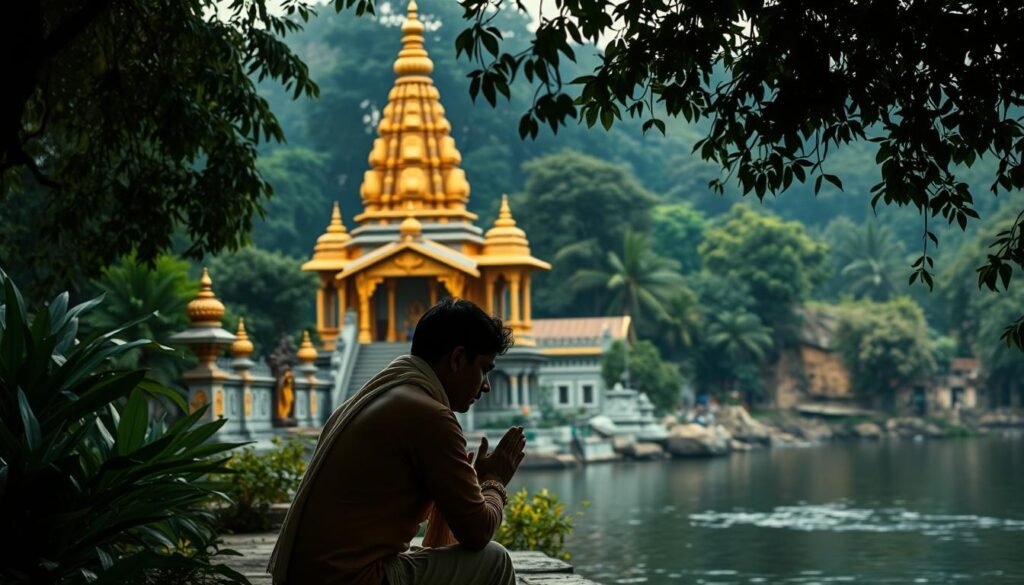Skanda Sashti is a big Hindu festival. It’s very important in southern India. It’s for Lord Murugan, the son of Lord Shiva and Goddess Parvati. This festival is on January 5, 2025.
To join in, people follow special rules. These rules help make the festival meaningful and rewarding.
Introduction to Skanda Sashti
It’s important to know the rules for Skanda Sashti. The festival is for thinking about ourselves, giving to others, and worshiping Lord Murugan. He stands for wisdom, strength, and leadership.
By following these rules, people can get more protection and courage. They can also get rid of obstacles in their lives.
Key Takeaways
- Skanda Sashti is celebrated on January 5, 2025
- The festival is dedicated to Lord Murugan, the son of Lord Shiva and Goddess Parvati
- Devotees follow Skanda Sashti fasting rules and Skanda Sashti vrat regulations
- The festival emphasizes personal reflection, charity, and worship of Lord Murugan
- Following the Skanda Sashti fasting guidelines can enhance protection, courage, and eliminate obstacles
- Skanda Sashti is a significant Hindu festival that holds great spiritual significance
- Understanding the Skanda Sashti fasting rules and Skanda Sashti vrat regulations is essential for a meaningful experience
What is Skanda Sashti?
Skanda Sashti is a big festival in Hindu mythology. It is celebrated with lots of devotion. The festival honors Lord Murugan, a powerful god who helps remove obstacles and brings peace.
To celebrate, people follow Skanda Sashti fasting guidelines. They do partial fasts, full fasts, and liquid fasts. These fasting practices are important.
The Skanda Sashti rituals are key to the festival. People chant mantras, visit Murugan temples, and do puja. The mantra “Sa Ra Va Na Bha Va” is special for Lord Murugan. It is chanted by devotees during the festival.
The festival lasts for six days. It starts on Sukla Paksha Pratama and ends on Shashti. This happens in the Tamil month of Aippasi, which is October-November.
- Partial Fast (Sa Uppavasam): One meal a day, typically consisting of simple, sattvic foods.
- Full Fasting (Nirjala Vrat): Complete abstinence from food and water for the duration of the festival.
- Liquid Fast: Consumption of only liquids such as water, coconut water, and fresh fruit juices.
By following these Skanda Sashti fasting guidelines and Skanda Sashti rituals, devotees can feel the spiritual benefits. They seek Lord Murugan’s blessings.
Historical Significance of Skanda Sashti
Skanda Sashti has a rich history tied to Hindu mythology. It celebrates Lord Murugan’s win over the demon Surapadman. This victory is seen as good winning over evil.
Every region has its own way of celebrating Skanda Sashti customs. People fast for six days. The fast ends on Soorasamharam, when Lord Murugan defeated Surapadman.
This festival is very important to Tamil Hindus. It shows the lasting power of Skanda Sashti traditions. The Kanda Sashti at Thiruchendur Murugan Temple is famous worldwide.

Skanda Sashti’s history shows the strong Skanda Sashti customs and traditions. It’s a big part of Hindu culture and faith. It shows the power of belief and devotion.
Key Rituals During Skanda Sashti
Skanda Sashti is a big festival in the Hindu calendar. Its rituals are key to the celebration. The festival includes Skanda Sashti fasting rituals like partial, full, and liquid fasting. Devotees also do Skanda Sashti prayer rituals, like chanting “Om Saravana Bhava” 108 times in the morning and evening.
The rituals help grow spiritually, stay disciplined, and show devotion to Lord Murugan. Some important rituals are:
- Offerings to Lord Murugan, such as fruits, flowers, and grains
- Chanting of the Skanda Sashti Kavasam, a protective hymn
- Performance of the Murugan Homa, a fire ritual that symbolizes the destruction of negativity and obstacles
These rituals are a big part of Skanda Sashti. They help people connect with Lord Murugan and ask for his blessings. By doing these rituals, people can grow spiritually, stay disciplined, and feel closer to their faith.
Skanda Sashti Fasting Rules
Skanda Sashti fasting rules are key to the festival. They involve not eating certain foods or doing certain activities. For six days before Skanda Sashti, people don’t eat grains or some foods.
This fasting helps clean their minds and bodies. It’s a way to get Lord Murugan’s blessings.
Types of Fasts Followed
- Partial Fast (Sa Uppavasam): Devotees eat one meal a day. It’s simple, sattvic food.
- Full Fasting (Nirjala Vrat): No food or water at all.
- Liquid Fast: Only water, coconut water, and fresh fruit juices are allowed.
- One Meal a Day: A vegetarian meal at night after prayers, avoiding onions and garlic.
Dos and Don’ts During Fasting
During Skanda Sashti fast, don’t eat meat, alcohol, or processed foods. Also, don’t sleep on a bed. Instead, sleep on the floor.
Drink more water than usual to stay hydrated. Following these rules brings spiritual and physical benefits. It helps seek Lord Murugan’s blessings.
Nutritional Guidelines for Skanda Sashti
During Skanda Sashti, people follow special Skanda Sashti nutritional guidelines. They eat vegetarian food and avoid grains and meat. Some eat only fruits, coconut water, and juices for six days.
The foods to eat are:
- Fruits, such as bananas and apples
- Vegetables, such as potatoes and carrots
- Whole grains, such as brown rice and quinoa
- Legumes, such as lentils and chickpeas
But, they should not eat:
- Non-vegetarian food, such as meat and fish
- Grains, such as wheat and barley
- Foods prepared with garlic and onion
- Alcoholic drinks and tobacco products

By sticking to these Skanda Sashti nutritional guidelines, people can have a healthy and spiritual time during the festival.
Benefits of Observing Skanda Sashti Fasting
Skanda Sashti fasting has many spiritual and physical benefits. It cleanses the mind and body. This is done through detox and better digestion.
By not eating non-vegetarian food, people feel closer to their faith. They also feel more peaceful inside.
The fasting lasts from dawn to dusk. Only foods like fruits and milk are allowed. This diet makes digestion better and helps with stomach problems.
During Skanda Shasti, people do special rituals. They give flowers and light lamps for Lord Murugan. These acts make them more mindful and in control.

- Detoxification and cleansing of the body
- Improved digestion and reduced gastrointestinal issues
- Increased devotion and inner peace
- Enhanced spiritual connection and self-control
Devotees gain a lot from these practices. They grow spiritually and feel better overall. This is the goal of Skanda Sashti spiritual benefits.
Tips for a Successful Skanda Sashti Fast
To have a great Skanda Sashti fast, get ready physically and mentally. Follow the Skanda Sashti tips and Skanda Sashti fasting tips. This will make your fast meaningful and spiritually rewarding.
It’s key to know why this fast is important. It helps us give to others by feeding the poor.
Some important Skanda Sashti fasting tips are to drink lots of water. Also, don’t eat meat and say hymns like Kanda Sashti Kavasam. You can pick from different fasts like Oru Pozhudhu/Pagal Viratham, Paal Viratham, Elaneer Viratham, or Milagu Viratham.
These fasts help remove marriage problems and bring calm and health.
Here are more Skanda Sashti tips to remember:
- Start getting ready for the fast a few days early. Eat light meals and avoid heavy foods.
- Drink lots of water and other fluids to stay hydrated.
- Recite hymns and prayers often to keep a positive mind.
- Don’t do hard activities and rest well.

Skanda Sashti in Different Regions of India
Skanda Sashti is celebrated with great fervor across various regions of India. It shows Skanda Sashti regional variations in rituals and customs. The festival is very popular in South India, like in Tamil Nadu, where it’s a big event for locals.
In Tamil Nadu, the Skanda Sashti celebrations include special poojas and abhishekams. These are done in temples dedicated to Lord Murugan, at the six abodes known as Arupadai Veedu. Devotees fast for six days, with different fasting practices, like complete fast or eating fruits and milk.
Some famous temples in Tamil Nadu for Skanda Sashti are Palani Murugan Temple, Thiruthani Murugan Temple, and Pazhamudircholai Murugan Temple. The festival celebrates Lord Murugan’s victory over the demon Surapadman, showing good winning over evil.
The Skanda Sashti regional variations show the diversity and richness of Indian culture. Each region adds its own special touch to the celebrations. By joining in these Skanda Sashti celebrations, devotees can feel the joy and spiritual meaning of this important festival.
Frequently Asked Questions about Skanda Sashti
Many people have Skanda Sashti questions. They want to know about its meaning, rituals, and fasting rules. We will answer Skanda Sashti FAQs here. Our answers will be clear and easy to understand.
Common Queries Answered
- What is the significance of Skanda Sashti?
- What are the rituals and fasting rules observed during Skanda Sashti?
- What are the benefits of observing Skanda Sashti?
Tips for First-Time Fasters
If you’re fasting for the first time, it’s key to know why. Skanda Sashti FAQs offer great advice. They help you enjoy this spiritual journey.
Conclusion and Final Thoughts on Skanda Sashti
As we wrap up our look at Skanda Sashti, we remember its deep spiritual meaning. This festival is special for Hindu followers. It’s about a six-day fast that tells the story of Lord Murugan’s win over Soorapadman.
This fast shows the strength of devotion and belief in beating challenges. By following Skanda Sashti rituals and fasting rules, people clean their minds, bodies, and souls. They want to get closer to Lord Kartikeya’s divine blessings.
Participating in the Skanda Sashti fast can change lives in many ways. It can bring spiritual growth, better health, and stronger marriages. We invite everyone to join in and feel closer to the divine.
It’s a chance to find guidance and blessings. It also adds to the beauty of Hindu traditions.
FAQ
What is the significance of Skanda Sashti?
Skanda Sashti is a special Hindu festival. It honors Lord Murugan, the son of Lord Shiva and Goddess Parvati. It’s very important in southern India and is celebrated with lots of devotion.
What are the key rituals performed during Skanda Sashti?
During Skanda Sashti, people fast, pray, and make offerings to Lord Murugan. They don’t eat grains or certain foods for six days. They pray and meditate, focusing on Lord Murugan and reciting his mantras.
What are the fasting rules for Skanda Sashti?
The fasting rules for Skanda Sashti are clear. People don’t eat grains or certain foods for six days. The article explains what to do and what not to do during this time.
What are the nutritional guidelines for Skanda Sashti?
The article gives nutritional tips for Skanda Sashti. It tells you which foods to eat and avoid. This helps keep your diet balanced while fasting.
What are the benefits of observing Skanda Sashti fasting?
Fasting during Skanda Sashti has many benefits. It cleanses the mind and body. The article talks about these benefits in detail.
How can one prepare for a successful Skanda Sashti fast?
The article offers advice for a successful fast. It covers preparation, staying hydrated, and keeping a positive mindset. These tips make fasting easier and more rewarding.
How is Skanda Sashti celebrated differently in various regions of India?
Skanda Sashti is celebrated in many ways across India. The article shows how different regions observe the festival. It highlights the unique rituals and customs of each area.
Shuchi Pandey is a distinguished author and scholar with a profound expertise in Hinduism with a leading voice in the study and interpretation of Hindu philosophy, rituals, and cultural traditions. She aims to bridge the gap between academic rigor and engaging storytelling by exploring the depths of Hindu thought, from the ancient Vedas to contemporary practices.


